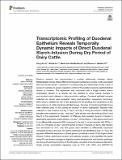Por favor, use este identificador para citar o enlazar a este item:
http://hdl.handle.net/10261/212839COMPARTIR / EXPORTAR:
 SHARE SHARE
 CORE
BASE CORE
BASE
|
|
| Visualizar otros formatos: MARC | Dublin Core | RDF | ORE | MODS | METS | DIDL | DATACITE | |

| Título: | Transcriptomic profiling of duodenal epithelium reveals temporally dynamic impacts of direct duodenal starch-infusion during dry period of dairy cattle |
Autor: | Li, C. J.; Lin, S.; Ranilla, María José CSIC ORCID ; Baldwin, R. L. | Palabras clave: | Ruminant Dairy Duodenal RNA seq analysis Starch Dry period Biopsy |
Fecha de publicación: | 2019 | Editor: | Frontiers Media | Citación: | Frontiers in Veterinary Science 6 (2019) | Resumen: | Previous research has demonstrated a positive relationship between dietary Metabolisable Energy Intake (MEI) and increased maintenance energy costs associated with the visceral tissues. Limitations in understanding this relationship include a lack of access to samples to assess regulatory control of the putative response gastrointestinal tissues to nutrients. This experiment was conducted with a single nutrient (starch hydrolysate) infused (7 d) directly into the intestine to mimic typical changes in post-ruminal starch delivery in dairy production settings. Duodenal epithelial samples collected via biopsy were evaluated using next-generation sequencing technology (RNA-Seq) to validate the use of this approach for the profiling and comparison of the transcriptome of cattle intestinal epithelial tissues. Samples of intestinal epithelial tissue were collected prior to and during the infusion of starch hydrolysate. Biopsies were collected on day 0 before and day 1, day 3, and day 7 during the infusion. Additionally, samples were collected on day 1 and day 7 after infusion was discontinued (Day 8 and Day14 of the experiment). Evaluation of RNA-seq data revealed dynamic changes in global gene expression during infusion. On day 7 of the infusion, 1490 genes were found to be differentially expressed (DE) compared to the day 0 control samples with FDR p < 0.05, vs. 105 genes on day 1 and 246 genes on Day 3. However, on day 8, after infusion was terminated for 24 h, only 428 genes were identified as differentially expressed compared to day 0 and only 107 genes continued to be identified by Day 14. Thus, the apparent differential expression of these genes is putatively a result of the single nutrient infused. Further, performing function and pathway analysis of the identified DE genes using IPA, we observe changes in digestive system development, and function pathways are among the primary functions of the DE genes, as well as immune response elements. Finally, primary transcription regulators such as PTH, JUN, WNT, and TNFRSF11B were identified as the activated upstream regulators for specific future focus. Using a serial biopsy approach we are able to identify differentially expressed genes from cow duodenal epithelial tissue in response to a short-term perturbation with infused starch hydrolysate. | Descripción: | 11 páginas, 4 tablas, 7 figuras | Versión del editor: | http://dx.doi.org/10.3389/fvets.2019.00214 | URI: | http://hdl.handle.net/10261/212839 | DOI: | 10.3389/fvets.2019.00214 | Identificadores: | doi: 10.3389/fvets.2019.00214 issn: 2297-1769 |
| Aparece en las colecciones: | (IGM) Artículos |
Ficheros en este ítem:
| Fichero | Descripción | Tamaño | Formato | |
|---|---|---|---|---|
| fvets-06-00214.pdf | 2,78 MB | Adobe PDF |  Visualizar/Abrir |
CORE Recommender
PubMed Central
Citations
1
checked on 23-abr-2024
SCOPUSTM
Citations
2
checked on 23-abr-2024
WEB OF SCIENCETM
Citations
2
checked on 27-feb-2024
Page view(s)
217
checked on 27-abr-2024
Download(s)
160
checked on 27-abr-2024

